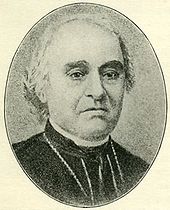François Norbert Blanchet
| François Norbert Blanchet | |
|---|---|
| Archbishop of Oregon City | |

Archbishop François Norbert Blanchet
|
|
| Archdiocese | Oregon City |
| See | Oregon City |
| Installed | July 24, 1846 |
| Term ended | December 12, 1880 |
| Predecessor | None (first bishop) |
| Successor | Charles John Seghers |
| Orders | |
| Ordination | July 18, 1819 |
| Consecration | July 25, 1845 |
| Personal details | |
| Born | September 30, 1795 Saint-Pierre, Rivière du Sud, Province of Quebec |
| Died | June 18, 1883 (aged 87) Portland, Oregon |
| Buried | St. Paul Cemetery, St. Paul, Oregon |
| Parents | Pierre Blanchet |
François Norbert Blanchet (September 30, 1795 – June 18, 1883) was a French Canadian-born missionary priest and prelate of the Roman Catholic Church who was instrumental in establishing the Catholic Church presence in the Pacific Northwest. He was one of the first Catholic priests to arrive in what was then known as the Oregon Country and subsequently became the first bishop and archbishop of the Archdiocese of Oregon City (now known as the Archdiocese of Portland in Oregon).
François Norbert Blanchet was born near Saint-Pierre, Rivière du Sud in Lower Canada (present-day Quebec). Along with his younger brother Augustin-Magloire Blanchet, he entered the Seminary of Quebec and was ordained a priest in 1819. Blanchet spent a year working at the cathedral in Quebec before being sent to do missionary work with the Micmac and Acadian people in present-day New Brunswick. To able to preach to the local Irish, Blanchet became fluent English. In 1827 he was summoned back to Montreal and became a pastor.
In the 1830s, John McLoughlin sent letters from French Canadian Catholic employees of the Hudson's Bay Company requesting from bishop Provencher of the Red River colony to send priests to what was then known as the Oregon Country. Bishop Provencher originally suggested that priests be set to the Willamette Valley but the Hudson's Bay Company pressed for the considered mission to be on the Cowlitz River, north of the Columbia River. Blanchet was appointed the Vicar General of the Oregon Country, with fellow priest Modeste Demers to aid in the missionary efforts. The missionaries were instructed by Archbishop Joseph Signay of Quebec to "In order to make yourselves sooner useful to the natives... you will apply yourselves... to the study of the Indian languages... so as to be able to publish a grammar after some of your residence there." The two priests along with nuns and lay people departed from Quebec on May 3, 1838 and traveled along the York Factory Express.
...
Wikipedia
